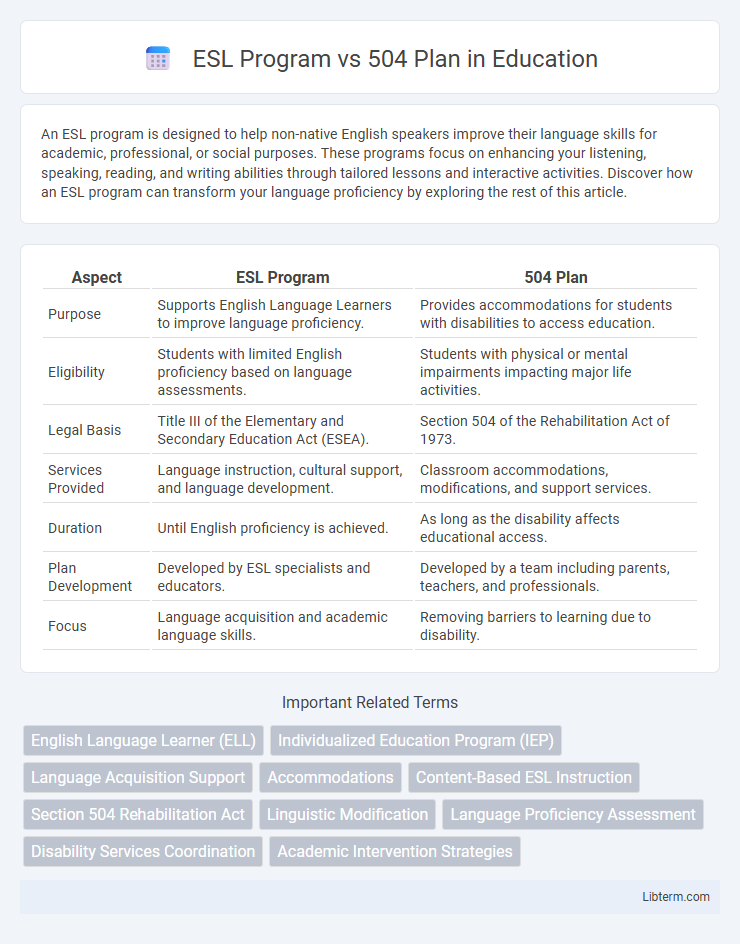An ESL program is designed to help non-native English speakers improve their language skills for academic, professional, or social purposes. These programs focus on enhancing your listening, speaking, reading, and writing abilities through tailored lessons and interactive activities. Discover how an ESL program can transform your language proficiency by exploring the rest of this article.
Table of Comparison
| Aspect | ESL Program | 504 Plan |
|---|---|---|
| Purpose | Supports English Language Learners to improve language proficiency. | Provides accommodations for students with disabilities to access education. |
| Eligibility | Students with limited English proficiency based on language assessments. | Students with physical or mental impairments impacting major life activities. |
| Legal Basis | Title III of the Elementary and Secondary Education Act (ESEA). | Section 504 of the Rehabilitation Act of 1973. |
| Services Provided | Language instruction, cultural support, and language development. | Classroom accommodations, modifications, and support services. |
| Duration | Until English proficiency is achieved. | As long as the disability affects educational access. |
| Plan Development | Developed by ESL specialists and educators. | Developed by a team including parents, teachers, and professionals. |
| Focus | Language acquisition and academic language skills. | Removing barriers to learning due to disability. |
Understanding the Basics: What Is an ESL Program?
An ESL (English as a Second Language) Program provides specialized instruction to help non-native English speakers develop proficiency in reading, writing, speaking, and understanding English. These programs focus on language acquisition to support academic success for students who are English learners (ELs). Unlike a 504 Plan, which offers accommodations for disabilities, ESL Programs specifically address language barriers to enhance communication and learning.
Overview: What Is a 504 Plan?
A 504 Plan is a formal accommodation plan under Section 504 of the Rehabilitation Act, designed to support students with disabilities in general education settings by providing necessary accommodations to ensure equal access to learning. Unlike ESL programs that focus on language acquisition for English learners, a 504 Plan addresses various physical or mental impairments impacting a student's educational performance. Schools develop individualized 504 Plans to remove barriers and promote inclusion without altering the curriculum content.
Key Objectives: ESL Program vs 504 Plan
The ESL Program aims to enhance English language proficiency for non-native speakers by providing specialized instruction in listening, speaking, reading, and writing skills. The 504 Plan focuses on removing barriers and providing accommodations for students with disabilities to ensure equal access to education without altering academic standards. Both plans address student needs but differ in their key objectives: language development versus disability support and accessibility.
Eligibility Criteria for ESL Programs
Eligibility criteria for ESL programs primarily depend on a student's limited English proficiency, typically assessed through language proficiency tests such as the WIDA ACCESS or the LAS Links. Students must demonstrate difficulties in reading, writing, speaking, or listening in English to qualify for targeted language instruction. Unlike 504 Plans, which address disabilities impacting learning, ESL programs focus specifically on acquiring English language skills for non-native speakers.
Eligibility Criteria for 504 Plans
Eligibility criteria for 504 Plans require the student to have a documented physical or mental impairment that substantially limits one or more major life activities, such as learning, reading, or concentrating. Unlike ESL programs, which focus on language proficiency levels and English language learner status, 504 Plans provide accommodations to students with disabilities to ensure equal access to education. Documentation from healthcare providers or educational assessments is typically required to establish eligibility under Section 504 of the Rehabilitation Act.
Types of Support Offered: ESL Programs
ESL programs provide targeted language support by offering specialized instruction in English language acquisition, including reading, writing, speaking, and listening skills tailored for non-native speakers. These programs often include sheltered content instruction, allowing students to learn academic subjects while developing English proficiency. ESL services also incorporate cultural orientation and social integration support to enhance student engagement and comprehension.
Types of Accommodations in 504 Plans
504 Plans provide specific accommodations to students with disabilities to ensure equal access to education, such as extended time on tests, preferential seating, and modified assignments. These accommodations differ from ESL programs, which primarily focus on language development through specialized instruction and language support services. While ESL programs target English proficiency, 504 Plans address broader physical or learning disabilities with tailored adjustments in the classroom environment.
Legal Frameworks: ESL vs 504 Plan
The ESL program operates under Title VI of the Civil Rights Act of 1964, ensuring language access for English language learners without discrimination. The 504 Plan is grounded in Section 504 of the Rehabilitation Act of 1973, providing accommodations to students with disabilities to guarantee equal educational opportunities. While ESL focuses on language proficiency support, the 504 Plan targets physical or mental impairments that substantially limit major life activities.
Parental and Student Involvement
Parental and student involvement in ESL programs centers on language acquisition support, where parents often engage through language workshops and communication with ESL instructors to enhance learning outcomes. In contrast, 504 Plans involve active collaboration between parents, students, and school staff to develop accommodations ensuring equal access to education for students with disabilities. Both frameworks emphasize ongoing communication and participation but differ in focus: ESL targets language development, while 504 Plans focus on disability-related educational adjustments.
Making the Right Choice: ESL Program or 504 Plan
Choosing between an ESL program and a 504 Plan hinges on a student's specific needs: ESL programs target language acquisition for English learners, providing tailored instruction to improve proficiency, while 504 Plans address disabilities or health impairments that impact learning, offering accommodations to ensure equal access. Understanding that ESL support focuses on linguistic development helps differentiate it from 504 Plan services designed to remove barriers caused by physical or cognitive impairments. Parents and educators should collaborate to evaluate whether language learning or disability accommodation is the primary concern to make an informed decision that maximizes educational success.
ESL Program Infographic

 libterm.com
libterm.com